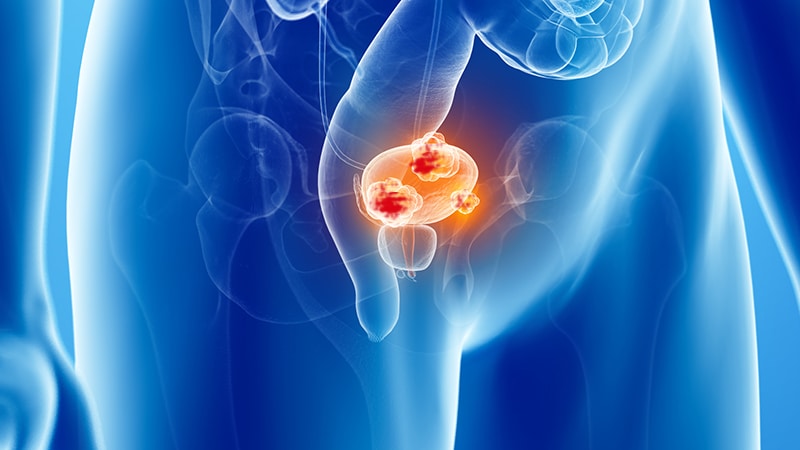Clinicians are not following guidelines that recommend a de-escalation in surveillance for patients with low-risk non–muscle-invasive bladder cancer (NMIBC), a new study concludes.
These cancers are associated with low rates of recurrence, progression, and bladder cancer-specific death, and so current clinical practice guidelines recommend against frequent monitoring and testing.
However, the study authors found that patients with a low grade Ta NMIBC diagnosis underwent a median of three cystoscopies per year and many also received a median of two imagine scans (CT or MRI) as well as 2-3 urine-based tests.
“These data suggest a need for ongoing efforts to limit overuse of treatment and surveillance, which may in turn mitigate associated increases in the costs of care,” write the authors, led by Kelly K. Bree, MD, from the Department of Urology, University of Texas MD Anderson Cancer Center, Houston. Bladder cancer has the highest lifetime treatment cost of all malignancies, they point out.
The study was published online March 18 in JAMA Network Open.
Higher Value and More Evidence Based
The impact of increased surveillance of this patient cohort has broad implications for patients and the healthcare system in general, say experts writing in an accompanying editorial.
“It has been well established that workup for NMIBC can have negative consequences for the physical and psychological health of patients,” note Grayden S. Cook, BS, and Jeffrey M. Howard, MD, PhD, both from University of Texas Southwestern Medical Center, Dallas.
“Many of these patients undergo frequent CT imaging of the urinary tract, which carries a high dose of radiation as well as the potential for financial toxic effects (ie, detrimental consequences to the patient because of health care costs),” they write.
Additionally, patient distress is a factor as they may experience preprocedural anxiety, physical discomfort during procedures, and worry about disease progression, they point out.
“The impact of these patterns is substantial and may have negative consequences for both patients and the healthcare system,” Cook and Howard conclude. “Thus, it is imperative to move forward with initiatives that provide higher value and are more evidence-based and patient-centered.”
Study Finds Frequent Surveillance
The American Urological Association (AUA)/Society of Urologic Oncologists (SUO), the European Association of Urology, and the International Bladder Cancer Group have made an effort to de-escalate surveillance and treatment for patients with low-grade Ta disease, while at the same time maintaining appropriate surveillance for high-grade aggressive disease.
However, the new study found that in practice, such patients undergo frequent testing.
The study involved 13,054 patients with low-grade Ta NMIBC. Most of the participants were male (73.5%), with a median age of 76 years, and had no or few comorbidities (71.2%).
Most patients had undergone cystoscopy, and rates increased over time: from 79.3% of patients in 2004 to 81.5% of patients in 2013 (P = .007). Patients underwent a median of 3.0 cystoscopies per year following their diagnosis, and upper-tract imaging was performed in most patients.
The use of kidney ultrasonography also rose from 19% of patients in 2004 to 23.2% in 2013, as did retrograde pyelography (20.9% in 2004 vs 24.2% in 2013). Conversely, the use of intravenous pyelography declined (from 14.5% in 2004 to 1.7% in 2012), but there was an increase in CT and MRI in all years except 2010 (from 30.4% of patients in 2004 to 47% of patients in 2013; P < .001). The rate of urine-based testing also significantly increased during the study period (from 44.8% in 2004 to 54.9% in 2013; P < .001), with patients undergoing between two to three tests per year.
Adherence to current guidelines remained similar during the study time frame. For example, 55.2% of patients received two cystoscopies per year in 2004-2008 compared to 53.8% in 2009-2013 (P = .11), suggesting that there was an overuse of all surveillance testing modalities.
As for treatment, 17.2% received intravesical immunotherapy with bacillus Calmette-Guérin, 6.1% were treated with intravesical chemotherapy (excluding receipt of a single perioperative dose). Disease recurrence within this cohort was 1.7%, and only 0.4% experienced disease progression.
When looking at the cost, the total median expenditures at 1 year after diagnosis increased by 60% during the study period, from $34,792 in 2004 to $53,986 in 2013. Higher costs were seen among patients who experienced a recurrence vs no recurrence ($76,669 vs $53,909).
The study was supported by a grant from the US Department of Defense Peer Reviewed Cancer Research Program. Several of the authors have disclosed relationships with industry, as noted in the original article. Editorialists Cook and Howard have disclosed no relevant financial relationships.
JAMA Netw Open. Published online March 18, 2022. Full text, Editorial
For more from Medscape Oncology, join us on Twitter and Facebook
Source: Read Full Article



